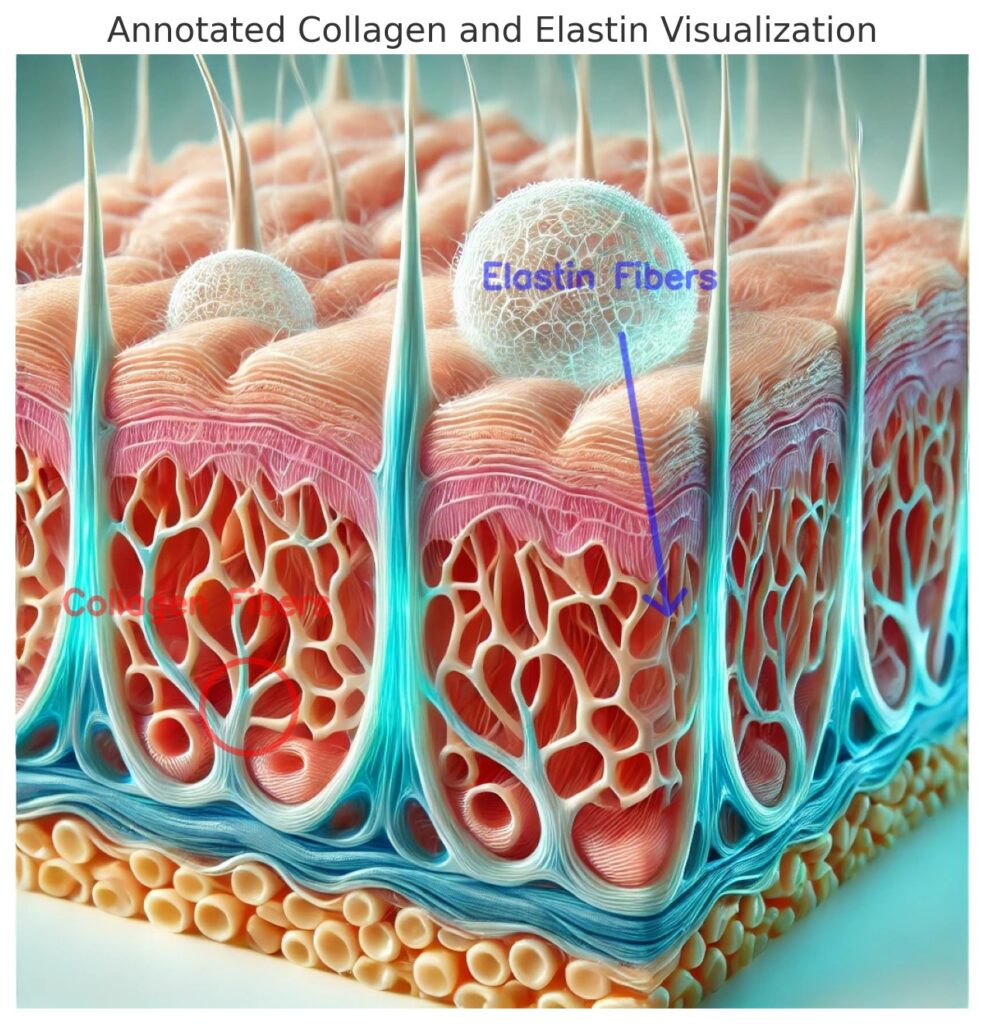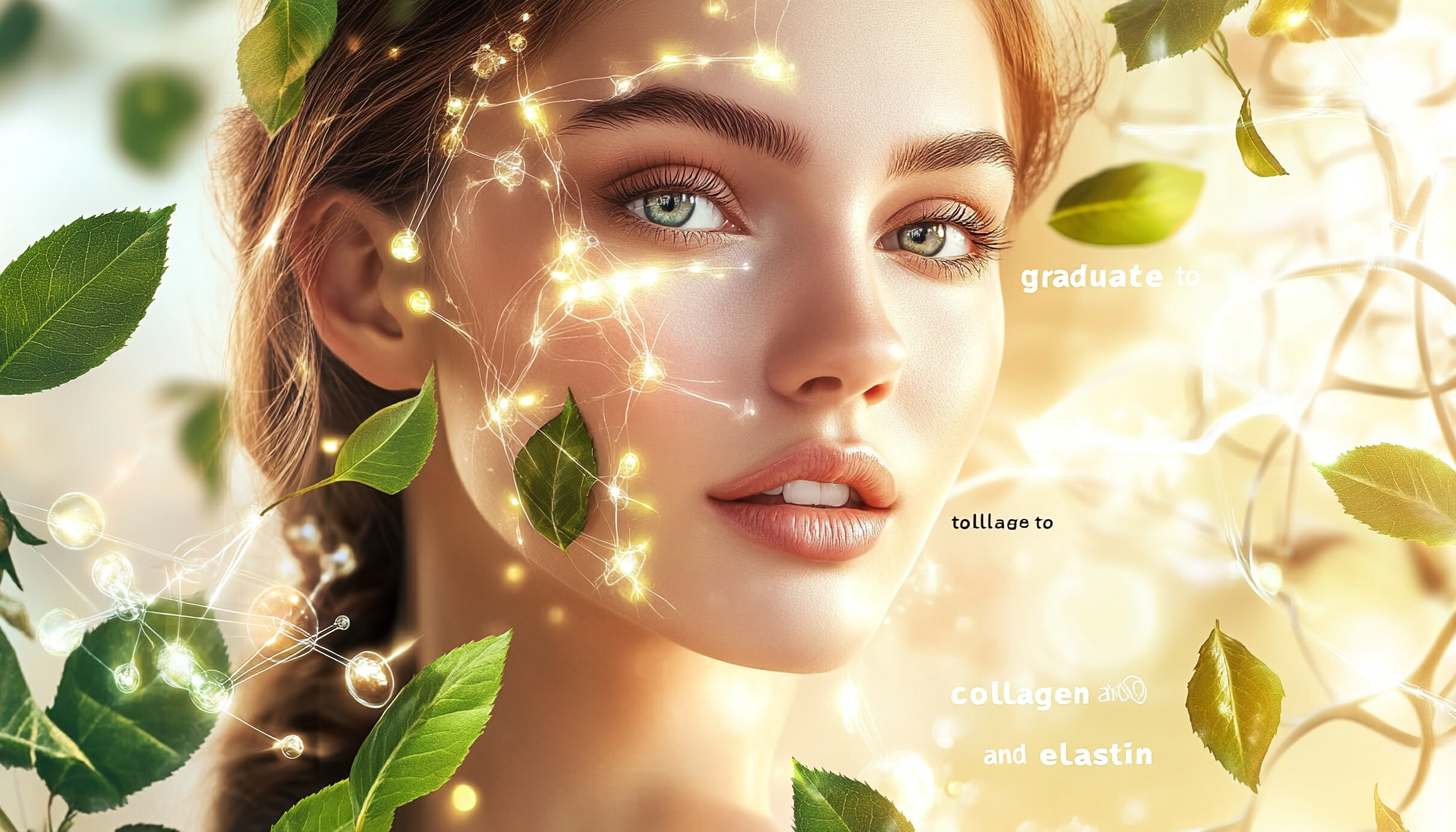
What Is Skin Elasticity and Why Does It Matter?
A while ago, I started noticing my skin wasn’t snapping back like it used to—kind of like a stretched-out balloon. That’s when I discovered the importance of skin elasticity. It’s your skin’s ability to stretch and return to its shape, thanks to two powerhouse proteins: collagen and elastin. They’re the duo that keeps your skin firm, flexible, and resilient.
But here’s the catch—starting in your mid-20s, collagen and elastin production slows down. Things like sun exposure, stress, and not-so-great habits speed up the process, leading to sagging skin, fine lines, thinning, and a loss of plumpness.
I remember the moment I noticed my smile lines weren’t disappearing—it was a wake-up call.
Thankfully, understanding skin elasticity is the first step to improving it. By boosting collagen and elastin, you can regain that bounce and keep your skin healthy and resilient. Start now, and your skin will thank you later—it’s worth it, trust me!
Factors That Affect Skin Elasticity
Skin elasticity doesn’t just disappear overnight—it’s impacted by a whole mix of factors, many of which are within our control (thank goodness!). I’ve had my fair share of moments where I didn’t treat my skin like it deserved, and let me tell you, it shows. Let’s break down what really messes with your skin’s bounce-back ability.
- Natural Aging Process and Hormonal Changes
Aging is the biggest culprit when it comes to reduced skin elasticity. I didn’t think much about it in my 20s, but as I hit my late 30s, I started noticing subtle changes. This is because, over time, our bodies produce less collagen and elastin—those proteins that keep our skin firm and stretchy. By the time you’re in your 40s, your skin’s ability to repair itself slows way down.
Hormonal changes also play a sneaky role. When estrogen levels drop (hello, perimenopause and menopause), so does collagen production. I noticed my skin feeling thinner and more delicate around my jawline as I got older. It’s just biology doing its thing, but it doesn’t mean we can’t fight back!
- Sun Exposure and UV Damage
Oh, the sun. It feels so good in the moment, but it’s like the ultimate skin villain. UV rays break down collagen and elastin fibers faster than anything else, leaving your skin saggy and wrinkled over time. I still kick myself for all those beach days in my 20s without sunscreen (SPF what?).
You might not notice the damage right away, but trust me, it builds up. Sun exposure also leads to dark spots and rough texture, which make your skin look even less elastic. If there’s one thing I wish I’d done sooner, it’s slather on sunscreen every single day—rain or shine.
- Poor Diet and Dehydration
Here’s the thing: your skin reflects what you eat and drink. I learned this the hard way after a summer of too many burgers and sodas. When your diet lacks nutrients like vitamins C and E, omega-3s, and antioxidants, your skin misses out on the building blocks it needs for elasticity.
And dehydration? It’s a killer. Without enough water, your skin looks dull and tired, and it feels tighter (not in a good way). I now keep a water bottle with me at all times—it’s a small habit that makes a huge difference.
- Smoking, Alcohol, and Other Lifestyle Factors
I’ll admit, I used to enjoy a glass of wine (or three) on the weekends, but over time, I noticed it taking a toll on my skin. Alcohol dehydrates you and causes inflammation, which breaks down collagen. Smoking, meanwhile, is like hitting the fast-forward button on aging. It reduces blood flow to your skin, leaving it dull and saggy.
Even lack of exercise can play a role. Movement helps improve circulation, delivering oxygen and nutrients to your skin. When I started doing yoga regularly, I noticed my complexion perked up—bonus points for stress relief, too!
- The Impact of Stress and Sleep on Skin Health
Speaking of stress, it’s a stealthy skin saboteur. When you’re stressed, your body produces more cortisol, a hormone that breaks down collagen and elastin. During a particularly hectic work period, I noticed my skin looking tired and droopy—almost overnight.
Sleep, on the other hand, is like magic for your skin. It’s when your body repairs itself, producing fresh cells and undoing some of the day’s damage. If I get less than 6 hours of sleep, it shows right away in my skin—puffiness, dullness, and just an overall blah appearance. Prioritizing 7-8 hours of quality sleep is one of the easiest ways to keep your skin looking youthful.

Best Skincare Practices for Elastic Skin
If there’s one thing I’ve learned from years of experimenting (and sometimes failing) with skincare, it’s this: consistency is key. And when it comes to maintaining or improving skin elasticity, there’s no magic shortcut—it’s all about sticking to the right practices. Let me break down what’s worked for me and what experts swear by.
- The Importance of Using Sunscreen Daily
If you’re not using sunscreen every single day, start right now. Seriously, it’s non-negotiable! I used to skip it, thinking I didn’t need it because I wasn’t “in the sun” much. Big mistake. UV rays don’t care if it’s cloudy or if you’re sitting indoors by a window—they’re sneaky and relentless.
Sunscreen protects your skin from the biggest collagen destroyer: UV damage. I noticed a huge difference in my skin after committing to a broad-spectrum SPF 30+ every morning. Not only did it stop my fine lines from getting worse, but it also gave my skin a healthier, more even tone over time. Pro tip: Don’t forget your neck and hands—they age just as fast as your face.
- Retinol and Peptides for Boosting Collagen Production
If sunscreen is the bodyguard, retinol is the personal trainer for your skin. Retinol (a form of vitamin A) works wonders by speeding up cell turnover and stimulating collagen production. I was nervous to try it at first because, let’s be real, retinol has a reputation for being harsh. But starting slow—using it twice a week and moisturizing like crazy—helped me avoid the dreaded redness and peeling.
Then there are peptides, which are like little messengers telling your skin to create more collagen. I’ve been using a peptide serum in the morning, and combined with retinol at night, my skin looks firmer and feels smoother.
- Hyaluronic Acid and Ceramides for Hydration
Hydration is everything when it comes to plump, elastic skin. Hyaluronic acid is my holy grail—it’s like a big glass of water for your face. It helps your skin hold onto moisture, making it look fuller and more resilient. I use a serum right after cleansing, while my skin is still damp, to lock in the hydration.
Ceramides are the unsung heroes of skincare. They strengthen your skin barrier, which means less water loss and more protection from environmental damage. My winter skin used to feel tight and flaky, but after adding a ceramide-rich moisturizer to my routine, it’s been smooth sailing—even in freezing weather.
- Regular Exfoliation to Promote Cell Turnover
Here’s where I’ve made some rookie mistakes. Over-exfoliating can wreck your skin barrier faster than you can say “sensitive skin.” That said, gentle exfoliation is essential for keeping your skin elastic. It removes dead skin cells, allowing your other products (like that pricey retinol serum) to penetrate better.
I stick to a chemical exfoliant with AHAs (alpha-hydroxy acids) twice a week. It’s less abrasive than scrubbing and helps with fine lines, dullness, and uneven texture. Remember, less is more—your skin isn’t a hardwood floor, so no need to sand it down!
Diet Tips for Improving Skin Elasticity
I’ll be honest—when I first heard the phrase, “You are what you eat,” I rolled my eyes. But as someone who’s seen firsthand how food impacts skin, I can tell you, it’s 100% true. Skin elasticity isn’t just about what you put on your skin—it’s also about what you feed your body. If you’re looking to improve your skin’s bounce-back ability, here are some tried-and-true dietary tips that actually work.
Foods Rich in Collagen-Boosting Nutrients: Vitamin C, Zinc, and Amino Acids
Collagen is the magic ingredient for keeping your skin firm and elastic, and your body needs the right building blocks to produce it. That’s where nutrients like vitamin C, zinc, and amino acids come in.
- Vitamin C: This powerhouse nutrient helps your body synthesize collagen and fights free radicals that can break it down. Citrus fruits like oranges and grapefruits are great, but don’t stop there—papaya, strawberries, and bell peppers pack a serious vitamin C punch too. I’ve been adding a handful of berries to my morning oatmeal, and it’s such an easy way to sneak in more skin-loving nutrients.
- Zinc: This mineral is crucial for repairing skin and boosting collagen. You’ll find it in foods like nuts, seeds, shellfish, and lean meats. I love snacking on pumpkin seeds—they’re tasty and full of zinc!
- Amino Acids: Since collagen is a protein, amino acids (the building blocks of protein) are essential. Bone broth is an incredible source, but eggs, beans, and lean poultry are great options too.
- The Importance of Omega-3 Fatty Acids for Skin Health
If you’re not getting enough omega-3s, your skin is missing out. These healthy fats help maintain your skin’s lipid barrier, which keeps it hydrated and plump. Omega-3s also reduce inflammation, which can contribute to skin aging.
Fatty fish like salmon, mackerel, and sardines are packed with omega-3s. Not a fan of fish? No worries—chia seeds, flaxseeds, and walnuts are plant-based options that work just as well. I’ve started adding ground flaxseed to my smoothies, and not only is it easy, but it makes me feel like I’m giving my skin a little extra love.
- Hydration: How Water and Herbal Teas Can Transform Your Skin
You’ve probably heard it a million times, but hydration really is key to keeping your skin elastic. When you’re dehydrated, your skin loses its plumpness and starts to look dull and tired.
Drinking enough water every day is non-negotiable, but I’ll admit plain water can get boring. That’s where herbal teas come in. Chamomile, green tea, and even hibiscus are not only hydrating but also loaded with antioxidants that support skin health. I’ve made it a habit to sip on green tea in the afternoons—it’s my little hydration boost with bonus skin benefits.
- Avoiding Processed Foods and Sugar for Better Skin Resilience
Cutting back on processed foods and sugar is one of the hardest but most effective changes I’ve made for my skin. Processed foods are often full of chemicals and inflammatory ingredients that mess with your body’s natural balance. And sugar? It’s a skin elasticity nightmare.
Sugar causes a process called glycation, which damages collagen and elastin fibers, making your skin more prone to sagging and wrinkles. I noticed a huge difference when I swapped out sugary snacks for fresh fruit or dark chocolate (70% cacao or higher). It’s not about being perfect—just making mindful choices most of the time.
Lifestyle Changes for Youthful, Elastic Skin
When it comes to skin elasticity, lifestyle changes are the unsung heroes. Sure, serums and fancy creams are great, but the way you live your life plays a huge role in how your skin looks and feels. Over the years, I’ve discovered that even small tweaks in daily habits can have a big impact. Let’s dive into the lifestyle changes that can give your skin that youthful, elastic glow.
- How Regular Exercise Improves Skin Elasticity
Exercise is one of the most underrated skincare hacks. I used to think hitting the gym was just about staying fit, but it turns out it’s also amazing for your skin. Regular exercise improves blood circulation, which delivers oxygen and nutrients to your skin. This helps your skin repair itself faster and keeps it looking plump and healthy.
I noticed a real difference in my skin’s elasticity after I started doing yoga and strength training regularly. The sweat sessions also help clear out toxins, leaving your skin with a natural glow. Plus, some exercises, like face yoga or Pilates, even target the muscles under your skin, helping to firm it up. Bonus tip? Don’t skip the post-workout hydration—it’s key to replenishing your skin.
- The Importance of Quality Sleep and Its Impact on Skin Repair
I’ll admit, I used to skimp on sleep, thinking I could get by on five or six hours a night. Bad idea. Sleep is when your body goes into repair mode, producing fresh skin cells and boosting collagen production. When you don’t get enough rest, your skin becomes dull, saggy, and prone to wrinkles.
Now, I prioritize a solid 7-8 hours of quality sleep every night. I even created a bedtime routine—turning off screens an hour before bed, using a calming lavender spray on my pillow, and keeping the room cool and dark. I can’t tell you how much better my skin looks and feels when I’m well-rested. Those under-eye bags? Gone. My advice: treat sleep like the ultimate beauty treatment—it’s free and works wonders.
- Stress Management Techniques: Mindfulness, Yoga, and Meditation
Stress is a sneaky saboteur of skin health. When you’re stressed, your body produces cortisol, which breaks down collagen and elastin over time. I’ve had periods where work stress made my skin look tired and less firm, almost overnight.
Practicing mindfulness and yoga has been a game-changer for me. Even 10 minutes of meditation a day can make a huge difference. I love apps like Calm or Insight Timer to guide me through relaxing breathing exercises. Yoga, especially gentle poses like child’s pose and downward dog, helps me release tension while improving circulation to my skin.
Another favorite? Journaling. It might sound cheesy, but writing down my thoughts helps me process stress and shift my mindset. The less stressed I am, the more my skin thanks me for it.
- Quitting Smoking and Reducing Alcohol Consumption for Healthier Skin
If you’re a smoker, this one’s tough to hear but so important: smoking is one of the worst things you can do for your skin. It constricts blood vessels, reducing oxygen flow and depleting your skin of nutrients. Over time, smoking damages collagen and elastin, leading to sagging and wrinkles. I’ve seen friends who quit smoking not only feel healthier but also see a noticeable improvement in their skin’s texture and elasticity.
Alcohol, while not as damaging as smoking, isn’t doing your skin any favors either. It dehydrates you and inflames your skin, which can make it look dull and less elastic. Cutting back doesn’t mean you can’t enjoy a drink now and then—I still love a glass of wine with dinner—but moderation is key. For every drink, I follow it up with a big glass of water, and my skin thanks me the next morning.
